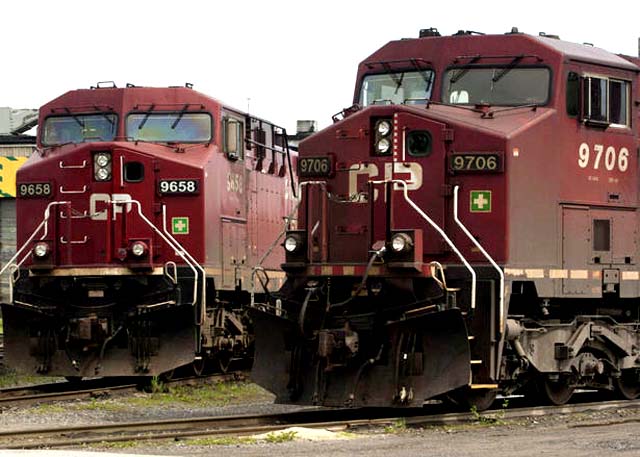
2012
|


Two Canadian Pacific Railway units at rest - Date/Photographer unknown.
20 June 2012
CP Rail Needs Much More Than a Quick Fix
Toronto Ontario - In the 127 years since the driving of the Canadian Pacific's last spike welded east to west, the railway and its
people have faced and overcome many crises and disasters. But can they avert their current train-wreck-in-waiting?
Just before a nine-day strike shut down the 23,000-kilometre railway and sidetracked its employees, CP was turned upside down by U.S. corporate raider Bill
Ackman, who convinced the other stockholders to dump the president and several directors. Ackman, who has large stakes in Target, J.C. Penney, and McDonald's,
alleged CP failed to deliver the profits he believes are buried in its transcontinental rail system.
Unfortunately, the old CP team gave Ackman some unintentional ammo. While serving on a string of consulting contracts between 1988 and 2009, I found CP enjoyed
a high degree of dedication among its unionized workforce and older managers, but the newer MBA-type execs were insular and detached from the reality of modern
railroading. They didn't understand it's like a high-stakes chess game, where you must check and checkmate your competitors to retain market share and expand
in sync with changing economic and trade patterns.
As the U.S. railways merged into a grid of five strong systems, CP showed little interest in checking this growing competition, which can siphon Canadian
freight traffic into the U.S. with feeder lines that breach our border. Even CN got into the game after the Liberal government sold the well-funded Crown
corporation at a discount. CP's few expansion efforts were non-strategic and too often botched.
CP, once the continent's second largest railway, sank to sixth position on the list of seven Class I roads, outflanked by these larger systems. A few
operational and executive blunders on top of this gave Ackman his opportunity to snatch control.
No one yet knows how Ackman intends to unlock the hidden wealth he says lurks in CP. He's suggested bringing former CN president Hunter Harrison back from
retirement in the U.S. to run it. Harrison has long boasted of his success in improving CN's operations and financial performance, but he doesn't discuss how
he alienated the public, the media, government, and many shippers while at its helm. Also missing from this so-called "CN miracle" is the fact that
Canadian taxpayers had made it North America's best railway physically decades before Harrison's arrival.
Ackman and Harrison have said the pathway to CP's success includes large cuts to its locomotive and rolling stock fleets. They want to copy CN, which wound up
under a similar plan with severe safety, customer satisfaction, and government relations problems.
Rumours abound about a fire sale of CP assets. The previous management team let the eastern end of the system wilt and become competitively inferior to CN. As
a result, one scenario has CP selling its lines east of Thunder Bay to shortlines or U.S. railways. A CP system without a strong eastern component is, in the
opinion of many industry insiders, unsustainable.
But there is another course that should be pursued by Ackman, faint hope though it may be. He could send in a management team that truly understands the game
of railroading and will lead him to the opportunities still awaiting a railway with a continental vision. The most obvious is a merger or takeover of the
Kansas City Southern, which stretches from Kansas City, where it connects with CP, all the way to Mexico's industrial heartland. This would create a
three-nation NAFTA system that the other large railways would find impossible to match.
To give CP and its investors a sustainable future, Ackman needs to re-envision it by adopting the philosophy of entrepreneur Warren Buffett. Through his
Berkshire Hathaway investment corporation, the "Sage of Omaha" paid US$34 billion in 2009 to buy 100 percent of Burlington Northern Santa Fe (BNSF),
North America's second largest railway.
Buffett says rail is the transportation mode of the future, hauling goods and people "in a cost-effective and extraordinarily environmentally friendly
way. I basically believe this country will prosper and you'll have more people moving more goods 10, and 20, and 30, years from now, and the rails should
benefit."
Most important, Buffett has backed up his belief by telling BNSF managers to reinvest properly in the railway and not focus on ever-growing quarterly
dividends. This has been a key failing of the North American railway industry and Buffett is writing a new formula for success by taking BNSF off this
treadmill.
That's the route Ackman needs to follow in the long-term interests of his hedge fund corporation, other CP investors, and the nation this epic railway helped
stitch together. Given the vital economic impact of CP, it's high time for him to tell the public, shippers, government, and the railway's 15,000 employees
what lies ahead. Let's hope it's based on a vision like Buffett's, whose BNSF has lines into Winnipeg, Vancouver, and southern Alberta and is a major CP
competitor.
Greg Gormick.

|
